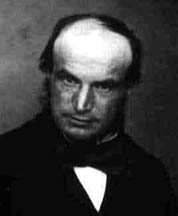![]()

|
Can you believe it?
Couch is one of over 300 mathematicians that have a lunar crater named after them. |
John Couch Adams was born in Cornwall, England in 1819 to a farming family. From a very early age he amazed everyone with his extraordinary abilities to do mathematical calculations in his head without the use of pen and paper. He was educated in mathematics at St. Johns College, Cambridge. While still an undergraduate, he performed an investigation to try to explain the reason for the irregularities in the motion of the planet Uranus. Adams theorized that the unexpected planetary orbit could be due to the presence of an as yet undiscovered planet in the vicinity. Adams theorized that the new planet was twice as far from the Sun as Uranus. All of the calculations were worked out in his head before he ever wrote them down. Once Adams did put his work on paper, he submitted it to the director of the Cambridge Observatory. The observatory took no action on his work. Several months later, Urbain Le Verrier submitted similar work to Johann Gottfried Galle, the director of the Berlin Observatory. Galle acted on Le Verrier's work and became the first person to observe Neptune. After the discovery of Neptune, the director of the Cambridge Observatory pointed out that John Couch Adams had been the first to predict the presence of Neptune. Le Verrier resented the effort to have Adams declared the sole discoverer of Neptune. Adams, a quiet, unambitious man was content to share the credit.
John Couch Adams made many other contributions to our knowledge of astronomy. For example, he studied the Leonid meteor shower and correctly concluded that the shower was the result of a comet passing close to Earth once a year. Adams was a mathematics professor at Cambridge and eventually became director of the Cambridge Observatory. He refused a knighthood offered by Queen Victoria to honor him for his accomplishments. Adams did not want the extra attention nor did he feel he had the money to maintain the lifestyle of a knight. He died in 1892 in Cambridge. Adams and his wife are buried under a 70 foot high granite cross in Cambridge. Three years after his death, he was honored with a memorial tablet in Westminster Abbey. The tablet is near the tablet that honors Sir Isaac Newton, another brilliant English mathematician.
A QuestionWhat instrument did John Couch Adams use to investigate the presence of a new planet beyond Uranus? |
| Did you know? |
The Answer |
![]()
| Show me the Level 1 version of this page. |
The StarChild site is a service of the High Energy Astrophysics Science Archive Research Center (HEASARC), within the Astrophysics Science Division (ASD) at NASA/ GSFC.
StarChild Authors: The StarChild Team
StarChild Graphics & Music: Acknowledgments
StarChild Project Leader: Dr. Laura A.
Whitlock
Curator:
Responsible NASA Official: